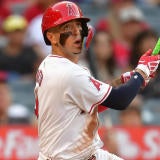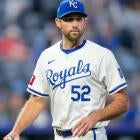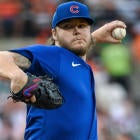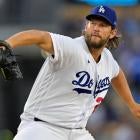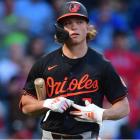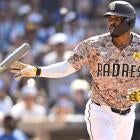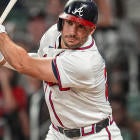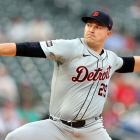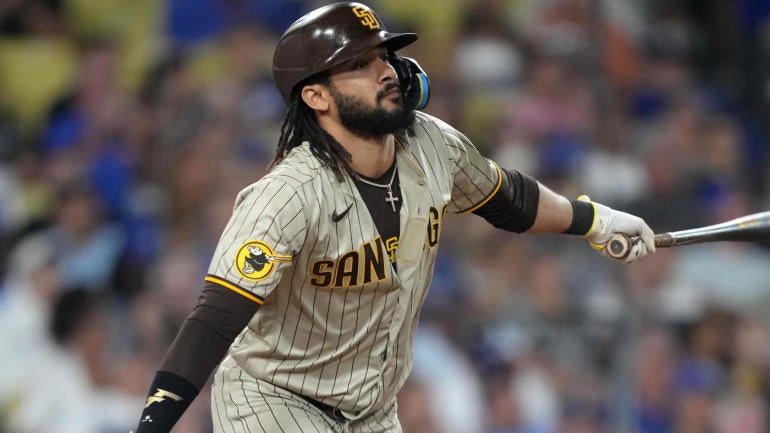
This is the toughest time of the MLB season to be doing Fantasy Baseball analysis, because there's just so little to go on. 14 of 30 teams have only played three games as of Monday afternoon, and only two have played more than four, which means we haven't even seen a full turn through the rotation for any team yet – the Dodgers and Padres have played six games, but their top two starters have already pitched twice.
With pitching analysis, we can at least look at stuff like velocity and pitch usage and try to draw some early conclusions – one start's worth of velocity data isn't super predictive, but it is stable at least. You can't fake throwing 4 mph harder, even if you might not be able to sustain it.
On the hitting side, of course, it's even tougher to do analysis. Typically, you want dozens, if not hundreds of plate appearances' worth of data to start drawing conclusions on the hitting side, and right now, we have, like, 12 PA for most hitters. You shouldn't be drawing any conclusions about hitters right now – except for Esteury Ruiz, who just got sent back to Triple-A after starting two of the first four games and can probably be dropped in most leagues at this point.
So, let's not draw any conclusions. Let's just look around the league for some early trends that might, if they continue, mean something in a few dozen (or hundred) plate appearances. I've got five different categories of early trends coming out of the first weekend of games you should know about, even if it might be too early to actually do anything about most of them:
New power sources?
There are seven hitters who have already hit a ball at least two miles per hour harder than any batted ball event in 2023. Why does that matter? Maximum exit velocity is a decent (though imperfect) proxy for raw power, and it's a stat that only takes a single event to show up.
Here's that list of seven:
- Joey Meneses -- 114.2
- Jared Walsh -- 112.5
- Fernando Tatis Jr. -- 116.7
- Luis Campusano -- 110.1
- Korey Lee -- 107.9
- Ben Rortvedt -- 108
- Brayan Rocchio -- 105.4
Now, in these cases, we're literally dealing with a single even sample size, obviously. But the thing about max exit velo is, you can't really fake it. A hitter can sneak a ball over the fence a few times in a week and not have that mean much of anything for his projections moving forward. But if that hitter hits a ball 110 mph for the first time ever, well, that just might be for real.
The question, of course, is whether it matters. Brayan Rocchio hitting a ball 105.4 mph probably doesn't matter that much; that's about the same as Steven Kwan's hardest-hit ball last season, a 16th percentile mark. Rocchio's max exit velo in Triple-A last season was just 107.4 mph, so we can pretty safely assume that power isn't going to be a big part of his game; his career high in a season is just 18, so even if he maximizes his launch angles and pulls the ball a whole bunch, you're probably looking at a ceiling in the teens for Rocchio in terms of homers – the appeal here, in as much as it exists, is in the 27 steals he had in 149 career Triple-A games, but even that leaves him as more of a deep categories league bench piece.
However, I think this represents a genuine reason to be optimistic about at least the top three names here. Tatis is a year further removed from wrist and shoulder surgeries, and his 116.7 mph batted ball is the hardest-hit ball he's ever had in the majors. He's off to a huge start, and I think we're going to see a big season from Tatis – of course, I expected that from him coming into the season.
Walsh was an All-Star back in 2021, but has had a pretty disastrous run since – he had thoracic outlet syndrome in 2021 that ultimately required surgery, and then he dealt with neurological symptoms in 2023 that led to insomnia, headaches, and depth perception issues. However, he had a nice spring for the Rangers and is getting an early opportunity to play with Nate Lowe on the IL. That 112.5 mph batted ball is his hardest-hit since he was an All-Star in 2021, and it's a sign that maybe he can recapture some of that form. In deeper leagues, I think he's actually an interesting add.
And then there's Meneses, who played through a knee injury for much of 2023 after a very promising partial-season in 2022. His 114.2-mph batted ball is the hardest ball he's ever hit in the majors by more than 3 mph, and he's also elevating the ball a ton, something he didn't do much of last season. It's probably too early for 12-team league participants to take notice, but it's something to keep an eye on for deeper leagues, because Meneses has strong contact skills and hits leadoff, making him a cheap source of RBI.
Also, if you'll indulge me for a second: Jo Adell has three batted balls this season. They've come off the bat at 102.4, 111.9, and 113.2 mph. I will never be able to quit him, no matter how many times he strikes out. I still believe!
Unexpected contact kings
- Jake Burger – 11.1% strikeout rate – It's four games. It's only four games. But Burger also showed improved contact skills after getting traded to Miami, so it's more like 57 games here. Will he sustain an 11.1% strikeout rate? No way! But after a spring where he struck out 17 times in 47 plate appearances, it's been good to see Burger get back to what made him so intriguing after the trade last season.
- Luis Campusano – 4.4% strikeout rate – The sample size is a little bigger here – five whole games! But this is another one where a player is simply building on last year's last breakout, as he struck out just 9.9% of the time after the All-Star break last season. Campuasno showed really strong contact rates for much of his minor-league career, but dealt with inflated strikeout rates once he get to Triple-A. That he's still making a ton of contact is a great sign, though he hasn't quite been able to pull off the "make a ton of contact and hit the ball hard" trick yet – he has just three hard-hit balls on 22 batted balls so far.
- Matt Chapman – 11.1 % strikeout rate – It's four games. It's only four games. And, in Chapman's case, there isn't a second-half improvement in 2023 to build on here. Which makes it easier to write off in Chapman's case. He hasn't had a strikeout rate below 27% since 2019, so I think the more relevant thing here is that Chapman is just crushing the ball right now, with a 62.5% hard-hit rate. It's a solid start, but not one I'm betting on continuing.
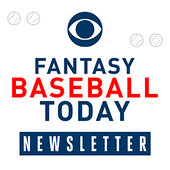
Fantasy Baseball Today Newsletter
Your Cheat Code To Fantasy Baseball
You're destined to gain an edge over your friends with advice from the award-winning FBT crew.
Thanks for signing up!
Keep an eye on your inbox.
Sorry!
There was an error processing your subscription.
Need for speed
The thing about stolen bases, as our Scott White has noted for years, is they are as much about desire and willingness as physical ability. Just because a player is running early in the season doesn't mean he will run all season long – Ramon Laureano stole eight bases in his first nine games in 2021 and had just four in his final 79 – but, all else being equal, you'd rather see a player running more than less, right? Right.
- Jose Siri already has three steals. Siri was in the 98th percentile in sprint speed last season, but stole just 12 bases last season. He came into the spring with a stated goal of stealing "more than 30 bases," and he's well on his way. From a guy who hit 25 homers last season, that's a pretty exciting thing.
- Brice Turang already has four! Injuries have created some opportunities for Turang to play a little more than expected early on, and he's responded with a strong start. He stole 26 bases last season, so we know he can be a cheap source of speed, but he needs to hit better than 2023's .218 mark for that to really matter.
- The Guardians have attempted 11 steals in four games. It's a new manager in Stephen Vogt,which could be relevant, but there's another factor I think we need to look at: Six of the steal attempts (all successful!) came in Kyle McCann's first MLB start. It might have just been a matchup thing, but this is a team with a decent amount of athleticism, so I'm hoping it carries over – Andres Gimenez especially benefited from being more aggressive on the bases last season, stealing 22 over his final three months of action.
- The Reds have attempted nine in three games. Here's another one that makes sense, given the players on the roster, though it's kind of funny that Bubba Thompson is tied for the team lead in attempts despite no plate appearances so far.
Leadoff notes
Lineups are just snapshots of a specific day and time, and early-season trends will be upended by injuries and
- Xander Bogaerts has led off all six games for the Padres. Bogaerts has a lot of contextual things going for him this season. More on that shortly.
- Jarren Duran has led off all four games for the Red Sox. They haven't faced a lefty starter yet, so that's where the real test is – I won't mind if Duran isn't hitting leadoff against lefties, as long as he's in the lineup more often than not.
- Gleyber Torres has led off all four games for the Yankees. With DJ LeMahieu on the IL with a fractured foot, Torres has the fortune of hitting ahead of Juan Soto and Aaron Judge.
- Jung Hoo Lee has led off all four games for the Giants. This was expected, but it's still good to get that confirmation. He has an average exit velocity of 95.8 mph so far, and while it's early, all signs are very positive for Lee so far. He could be a must-start Fantasy option.
- Jonathan India has led off all three games for the Reds. India went from having real playing time concerns at the beginning of the spring to being the everyday leadoff hitter for what could be a very good offense. If he can stay healthy – plantar fasciitis was a significant issue for him last season and throughout this offseason – India could end up one of the biggest steals in the league.
- Connor Joe has led off all five games for the Pirates. My assumption here is that Joe is going to hit leadoff against lefties, and the Pirates just happened to have faced five lefties in a row to open the season. I wonder what the record for most games against a LHP to open the season is, because five in a row has to be pretty close, right?
- Sal Frelick has led off two of four games for the Brewers. Jackson Chouiro led off the other game against a lefty, while hitting ninth against righties. It's a nice sign for Frelick, but I'd expect Chourio to force his way up against righties before long.
Eligibility updates
Only two teams have played enough games for their players to gain new eligibility, and as far as I can tell, there is only one hitter that has actually done it. Still, coming out of the first weekend, let's take a look at some early notes – I will not be commenting on all of these, by the way.
- Xander Bogaerts: Gained 2B eligibility! We knew this was coming, and you should have been approaching Bogaerts with the expectation of moving him into your 2B spot by this point. Not that you can't use him at SS, but Bogaerts probably fits most lineups better at 2B.
- Spencer Steer: Needs four games for 2B. Steer already has 1B, 3B, and OF eligibility, so we shouldn't be greedy. But quadruple (sextuple in leagues with MI and CI!) eligibility would sure be nice.
- Jake Burger needs three more games for 1B. This one probably doesn't matter too much, but flexibility is nice.
- Christopher Morel needs two more games for 3B. He'll almost certainly get to five games this week, but Morel is enough of a butcher in the field that there's a certain race against time element here.
- Henry Davis needs one more game for C. It's unfortunate that the way the schedule worked out, you won't be able to use Davis as a C until Week 3, but I'm expecting him to be locked into that spot for the rest of the season.
- Justin Turner needs three more games for 3B.
- Kris Bryant needs four more games for 1B
- Colt Keith needs two more games for 2B.
- Curtis Mead needs three more games for 2B.
- Jared Triolo needs one game for 2B and four games for 1B.
- Amed Rosario needs three games for OF.
- Davis Schneider needs four games for OF.
- J.D. Davis needs three more games for 1B.
- Willi Castro needs four more games for SS.
- Whit Merrifield needs four more games for 3B.
- Joseph Ortiz needs two more games for 3B.
- Oswaldo Cabrera needs two more games for 3B and four games for SS.
- Graham Pauley needs four more games for 1B.
- Michael Busch needs two more games for 1B.


